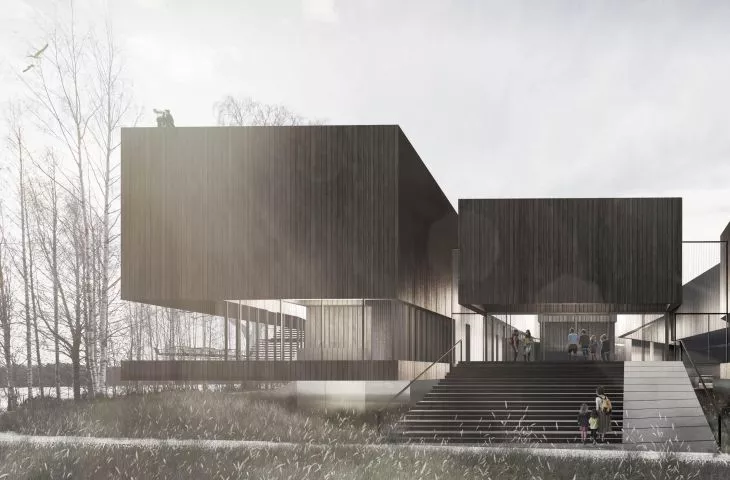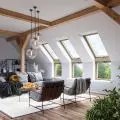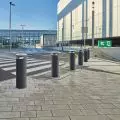Studio Maksymilian Sawicki Arkitektur , together with architects from Poznań, created a design for the new headquarters of the Norwegian museum, located on a site next to the Glomma River - the largest river delta in northern Europe. The building, derived from the idea of ecotone, took part in the international competition "Nasjonalt fløtingsmuseum og kompetansesenter for våtmark."
Fetsund is a unique place in Norway where nature, knowledge, culture and industry meet. The proposal by the team consisting of: Michal Ankiersztajn, Hanna Sawicka, Maksymilian Sawicki and Wojciech Swarowski represents a transitional area between these main determinants, combined in an architectural idea. The project "Nasjonalt fløtingsmuseum og kompetansesenter for våtmark," which in free translation means National museum of floating timber together with a competence center for wetlands, has become an ecotone between architecture and nature.
An ecotone, according to the Encyclopaedia Brytanica, is a transition zone between separate communities, possessing features characteristic of each of the adjacent zones, but often also those not found in overlapping ecosystems. The transition zone, which is an ecotone, is often richer than each of the collections separately.
A view of the museum from the water side
vision: Piotr Misiorny © INAINN ARCHITECTS, Michal Ankiersztajn, Wojciech Swarowski
continuation of tradition
The museum project is a platform for knowledge exchange between the scientific and academic communities. The new site is a continuation of the cultural core built within the Museums in Akershus institution, connected to other museums. It showcases more thana century of tradition in the wood industry and local Norwegian manufacturing.
As the architects say about the idea and form of the project:
Our architectural response is deeply rooted in the natural surroundings and coexistence with them. The designed structure consists of three elongated elements, situated parallel to the shoreline and gently refracted, thus leaving the impression of being pushed by the flow of water. The idea of the National Museum in Fetsund is strongly related to the forms and shapes, which are relics of the raw timber floating industry, that can still be found on the Glomma River today. The way the original platforms are arranged and connected on the water, forming a pattern, is part of the unique sculpture of the roof, designed to be viewed from the terrace.
design stages and inspiration
© INAINN ARCHITECTS, Michal Ankiersztajn, Wojciech Swarowski
Divided into three parts, the mass of the museum continues the direction of the adjacent river. The architectural form is separated by water channels called "inner Glomma's," allowing easy and flexible access to each part of the building and good visibility of the exhibition spaces. "Inner Glommas", thanks to ramps, provide access to the gardens below. The museum can be reached by land - by amphitheater-type stairs, and from the water by private boat, arriving at the pier, located near the restaurant.
The facility is divided into three parts
© INAINN ARCHITECTS, Michal Ankiersztajn, Wojciech Swarowski
Theright side of the blockconsists of the research and administration department, with a separate controlled entrance for employees. In the left wing of the building, visitors will find not only exhibitions related to the history of the wetlands and workshop space, but also a public boutique, café and restaurant with a rooftop observation deck. Flexible exhibition spaces allow the arrangement of both large and small exhibits, and through the use of roof louvers, allow sunlight-sensitive exhibits to be displayed.
A separate outdoor workshop building provides a venue for outdoor education. Having a pontoon platform as its base, the building is adapted to flood conditions. Its roof space is a multifunctional terrace, which is also a terminal for people waiting for canoeing or water transportation home.
care for the environment
The building is designed in wood construction - the facades can be made by localwoodcarvers. Glazed facades, are covered at the front with a layer of bird-friendly vein curtains to protect migrating birds from colliding with invisible glazing. Structural cores beneath the building, with organically shaped wooden niches, are covered withan interactive, mirrored surface that reflects the surrounding nature and lets light into the ground-floor gardens. Surfaces designed for pedestrian or vehicular traffic are made of natural, environmentally friendly, locally occurring materials.
Glazed facades, are covered with veil curtains
vision: Wojciech Janicki © INAINN ARCHITECTS, Michal Ankiersztajn, Wojciech Swarowski
The museum was designed to allow daylight to reach the rooms through controlled roof panels. The wooden facade also serves as a natural blocker of sunlight. The horizontal architectural form was planned with an awareness of counteracting light pollution in the area and prevents the building from overheating. The museum's masses sited parallel to each other, precisely divided into transition zones, provide space for natural air conditioning and ventilation. Water from flooding and precipitation can be temporarily stored under the building, giving the landscape a new quality.
On the next page we publish an interview with INAINN ARCHITECTS studio.





































